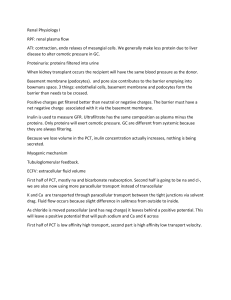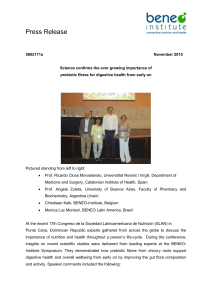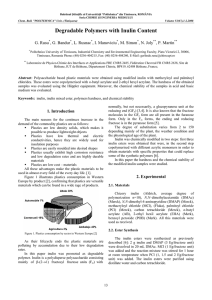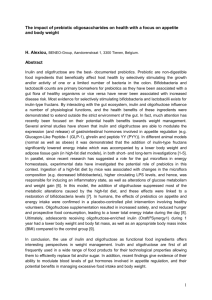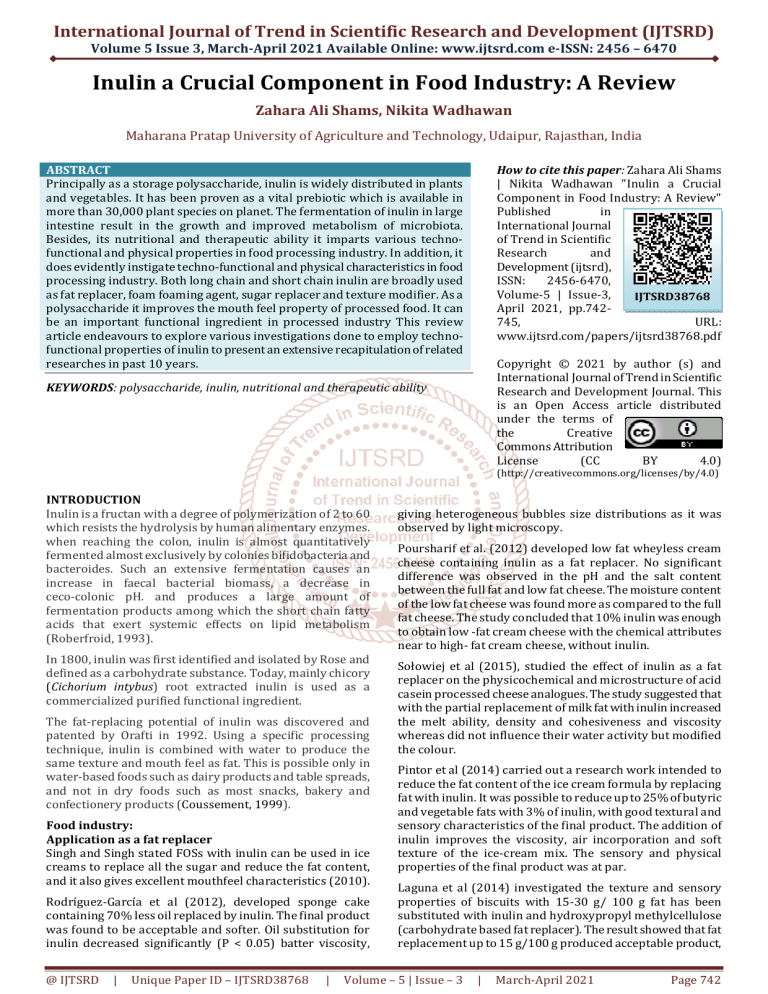
International Journal of Trend in Scientific Research and Development (IJTSRD) Volume 5 Issue 3, March-April 2021 Available Online: www.ijtsrd.com e-ISSN: 2456 – 6470 Inulin a Crucial Component in Food Industry: A Review Zahara Ali Shams, Nikita Wadhawan Maharana Pratap University of Agriculture and Technology, Udaipur, Rajasthan, India How to cite this paper: Zahara Ali Shams | Nikita Wadhawan "Inulin a Crucial Component in Food Industry: A Review" Published in International Journal of Trend in Scientific Research and Development (ijtsrd), ISSN: 2456-6470, Volume-5 | Issue-3, IJTSRD38768 April 2021, pp.742745, URL: www.ijtsrd.com/papers/ijtsrd38768.pdf ABSTRACT Principally as a storage polysaccharide, inulin is widely distributed in plants and vegetables. It has been proven as a vital prebiotic which is available in more than 30,000 plant species on planet. The fermentation of inulin in large intestine result in the growth and improved metabolism of microbiota. Besides, its nutritional and therapeutic ability it imparts various technofunctional and physical properties in food processing industry. In addition, it does evidently instigate techno-functional and physical characteristics in food processing industry. Both long chain and short chain inulin are broadly used as fat replacer, foam foaming agent, sugar replacer and texture modifier. As a polysaccharide it improves the mouth feel property of processed food. It can be an important functional ingredient in processed industry This review article endeavours to explore various investigations done to employ technofunctional properties of inulin to present an extensive recapitulation of related researches in past 10 years. Copyright © 2021 by author (s) and International Journal of Trend in Scientific Research and Development Journal. This is an Open Access article distributed under the terms of the Creative Commons Attribution License (CC BY 4.0) KEYWORDS: polysaccharide, inulin, nutritional and therapeutic ability (http://creativecommons.org/licenses/by/4.0) INTRODUCTION Inulin is a fructan with a degree of polymerization of 2 to 60 which resists the hydrolysis by human alimentary enzymes. when reaching the colon, inulin is almost quantitatively fermented almost exclusively by colonies bifidobacteria and bacteroides. Such an extensive fermentation causes an increase in faecal bacterial biomass, a decrease in ceco-colonic pH. and produces a large amount of fermentation products among which the short chain fatty acids that exert systemic effects on lipid metabolism (Roberfroid, 1993). In 1800, inulin was first identified and isolated by Rose and defined as a carbohydrate substance. Today, mainly chicory (Cichorium intybus) root extracted inulin is used as a commercialized purified functional ingredient. The fat-replacing potential of inulin was discovered and patented by Orafti in 1992. Using a specific processing technique, inulin is combined with water to produce the same texture and mouth feel as fat. This is possible only in water-based foods such as dairy products and table spreads, and not in dry foods such as most snacks, bakery and confectionery products (Coussement, 1999). Food industry: Application as a fat replacer Singh and Singh stated FOSs with inulin can be used in ice creams to replace all the sugar and reduce the fat content, and it also gives excellent mouthfeel characteristics (2010). Rodríguez-García et al (2012), developed sponge cake containing 70% less oil replaced by inulin. The final product was found to be acceptable and softer. Oil substitution for inulin decreased significantly (P < 0.05) batter viscosity, @ IJTSRD | Unique Paper ID – IJTSRD38768 | giving heterogeneous bubbles size distributions as it was observed by light microscopy. Poursharif et al. (2012) developed low fat wheyless cream cheese containing inulin as a fat replacer. No significant difference was observed in the pH and the salt content between the full fat and low fat cheese. The moisture content of the low fat cheese was found more as compared to the full fat cheese. The study concluded that 10% inulin was enough to obtain low -fat cream cheese with the chemical attributes near to high- fat cream cheese, without inulin. Sołowiej et al (2015), studied the effect of inulin as a fat replacer on the physicochemical and microstructure of acid casein processed cheese analogues. The study suggested that with the partial replacement of milk fat with inulin increased the melt ability, density and cohesiveness and viscosity whereas did not influence their water activity but modified the colour. Pintor et al (2014) carried out a research work intended to reduce the fat content of the ice cream formula by replacing fat with inulin. It was possible to reduce up to 25% of butyric and vegetable fats with 3% of inulin, with good textural and sensory characteristics of the final product. The addition of inulin improves the viscosity, air incorporation and soft texture of the ice-cream mix. The sensory and physical properties of the final product was at par. Laguna et al (2014) investigated the texture and sensory properties of biscuits with 15-30 g/ 100 g fat has been substituted with inulin and hydroxypropyl methylcellulose (carbohydrate based fat replacer). The result showed that fat replacement up to 15 g/100 g produced acceptable product, Volume – 5 | Issue – 3 | March-April 2021 Page 742 International Journal of Trend in Scientific Research and Development (IJTSRD) @ www.ijtsrd.com eISSN: 2456-6470 but as the replacement increased the overall acceptability decreased. There was no significant difference was observed in the overall acceptability and appeal of the final product. Tiwari et al (2014) studied the influence of the inulin as fat replacer on the quality of ice cream. Fat was substituted by inulin at 2%, 4% and 6% and compared with the 10% fat icecream. The 2% and 4% substitution were found to be at par with the 10 % fat ice cream. Alaei et al (2018) studied the effect of long chain inulin as a fat substitute in the formulation of sausage emulsion system. The experiments were carried out to investigate the effect of inulin on the physicochemical, sensory and textural properties of chicken sausages. Overall, the substitution of the entire fat existing in the formulation of the sausage with inulin led to the best physicochemical, textural, colorimetric, and sensory results. The use of inulin could be recommended as a fat substitute in the formulation of chicken sausages. In 2015, Mensink et al reviewed the physicochemical characteristics of inulin. The review stated that the degree of polymerization – sensitive gel forming and viscous behaviour of inulin tend to make it more suitable as a fat replacer. Inulin is used to modify texture or replace fat in food, its DP-sensitive gel forming and viscous behavior make it suitable for that purpose. Additionally, the (2→1) linked fructosyl residues of inulin are not hydrolyzed by the human digestive enzymes, enabling low-calorie replacement of fat. The partially hydrolyzed form of inulin, oligofructose (DP ≤ 10), has this same feature and is sweeter, and is therefore used as a low-calorie sugar replacer. Their indigestibility makes both inulin and oligofructose suitable as dietary fibers. As microbiota in the colon are capable of breaking down inulin, it is also used as a prebiotic and to prepare gels for targeted drug release in the colon. In 2006 García et al studied the effect of adding inulin as fat replacer in mortadella, a Spanish cooked meat product on the quality of sensory and textural properties. It can be established that this product can be enriched with inulin to a maximum level of 7.5% and preferably as gel with a good sensory quality. Cegiełka and Tambor (2012) carried out experiments in order to develop low calorie chicken burger by adding inulin. The study analysed the effect of addition of inulin on the physical, chemical and sensory quality of the polish chicken burger. the application of inulin did not cause significant decrease of the thermal processing yield nor the shear force of the products. The addition of inulin resulted in slight, but significant differences (P < 0.05) in chemical composition and energy value of burgers. In 2014, Furlán et al developed the low fat minced meat by adding bovine plasma protein and inulin as fat replacer. The resultant product had 20-35% low fat and enriched with the protein and inulin as functional component. When compared with the full fat minced meat no change in colour, flavour and taste was observed. Keenan et al (2014) studied the effect of inulin as fat replacer on the quality of breakfast sausage. In total 17 treatments were developed to assess composition, sensory, instrumental texture and colour characteristics and found out that with increase in the inulin content tenderness decreases. Two most acceptable sausage formulations were selected showing significantly lower fat levels than the control, which would contain sufficient inulin to deliver a prebiotic health effect. Berizi et al. (2017) investigated the prospect of developing low energy emulsion type sausages by substituting fat with inulin. The fat was reduced to 6%-18% and substituted by inulin and water. Chemical and texture profile analysis done to determine the quality of the final product. the study concluded inulin as good fat rep lacer in emulsion type sausages as the result showed significant decrease in the total energy value upto 64% (6% inulin and 12% water). @ IJTSRD | Unique Paper ID – IJTSRD38768 | Thøgersen et al (2020) investigated the effect of inulin incorporated pork sausage on the endogenous formation of nitroso compound after consumption in rats. Although no significant effect of fortification on the oxidative product in liver and plasma was found. But a reduction was observed in the fecal nitroso compound in rat which revealed that inulin fortification in food processing could contribute to make healthier food. Thickening agent: Inulin is a significant ingredient in food industry because of its diversified nutritional and functional properties. An increase in the inulin concentration improves the texture of product because of its degree of polymerization. Rad et al 2012, Showed that inulin can be used as a thickening agent. The study was performed to investigate the role of inulin as a thickening agent in flavoured milk sweetened with stevia. Results showed improved texture and viscosity of the dietetic chocolate milk. The viscosity and sedimentation rate of final product with 100% sweetener replacement using 6% inulin and 50 % sweetener replacement with 4-6% inulin found to be such as the control one. It was suggested that overall increase in the quantity of inulin enhanced the viscosity and sedimentation properties of final product. Saeed et al (2015) identified physicochemical significance of inulin. It showed that the short chain fraction of inulin exhibits more solubility and sweetness as compared to other long chain oligosaccharides. Further, inulin concentration raised the acidity and total solid in the fermented liquid dairy products and can be proven as good fat replacer in dairy industry by enhancing noticeable differences in the flavour, colour and texture of the final product. Furlán et al (2017) also investigated the role of inulin as a surfactant or stability agent on white compound chocolate sweetened with sucralose and stevia. The shelf life of the inulin incorporated product found to be higher than the control one without replacement. Compound chocolate with inulin at 10% w/w showed a dense matrix structure, reducing the size and number of fat crystals formed during storage; furthermore, they presented higher values of brightness. In 2017, to assess the effect of sweeteners combinations and inulin over the dairy desserts was studied by Furlán and Campderrós. The intend of study was to examine the impact of inulin as a fat mimetic on physicochemical properties of dairy desserts. It was demonstrated that addition of inulin to the fat reduced dessert sweetened with the sucrose replacers lowered the syneresis, eventually increases the stability. Volume – 5 | Issue – 3 | March-April 2021 Page 743 International Journal of Trend in Scientific Research and Development (IJTSRD) @ www.ijtsrd.com eISSN: 2456-6470 Alizadeh et al (2018) developed low-calorie, sucrose-free mango nectar with incorporating stevia as a low-calorie sugar replacer and inulin as a prebiotic texturizer in order to compensate sugar elimination defect on viscosity and °Brix. It was confirmed that utilizing 6% w/w inulin and 3% w/w stevia produced the optimum mango nectar with the desirability of 0.85 without undesirable changes in the physicochemical and organoleptic properties. Application as a gelling agent Neito-neito et al (2015) studied the effect of adding inulin (0.1%-0.5%) on the formation of strong oat protein gels at neutral pH by increasing compressive stress of the gel. It was reported that inulin also demonstrated the filling effect by forming nanoparticles in the blank spaces of the protein network and create junction zones. In 2020, Florowska et al conducted an investigation to ascertain the possibility of inducing inulin gels by using high hydrostatic pressure (HHP) and compared with the gels induced traditionally. It was reported that HHP gels differ from traditional gels, had different microstructure and distribution of primary particles. In consequences HHP gels, comparing with thermally and mechanically induced ones, were less firm and spreadable and were characterized by a higher yield stress. Those properties may allow using inulin gels for creating new and innovative products. Beccard et al (2019) studied the structural properties and mechanical response of inulin gel prepared from the long chain inulin. The results showed a high sensitivity of the structural and textural properties of inulin gels to the variation of applied temperature and shearing during sample preparation. Application as a sweetening agent Gheybi et al 2017 studied the use of stevia and inulin as sugar and fat replacer in dietetic ice cream. The Optimum content of stevia and inulin was determined 42% and 62.9% respectively, in Dietetic ice cream. The total value of calorie of diet ice cream was reduced by 28% as compared to the controlled ice cream. No significant difference in overall acceptability was observed between the diet icecream and the controlled. It was reported that dietetic ice-cream scored lower for intensity of crystalline and coldness. Farzanmehr and Abbasi (2009) studied the effect of inulin , polydextrose and maltodextrin as bulking and sweetening agent instead of sugar in manufacturing of milk chocolate. The optimum applicable range for inulin, polydextrose and maltodextrin were 14–32% and 71–84%, 7–26% and 67– 77%, and 0–20% of sugar substitutes, respectively. The study reported that inulin, polydextrose and maltodextrin can be used as sugar replacer in order to produce low calorie milk chocolate. Aidoo et al (2014) investigated Optimum level of inulin and polydextrose mixtures as sucrose replacers in manufacturing of sugar free chocolate. Chocolate formulation consisting of 75.3594% polydextrose and 24.6406% inulin was found as the optimum concentrations producing the most acceptable rheological and physical quality characteristics. Stoyanova et al. studied the capability of scavenging reactive oxygen species of inulin along with stevioside in 2010. It was reported that Inulin and Stevioside are superior scavengers of both hydroxyl and superoxide radicals, more effective than mannitol and sucrose. It was quoted Within the plant vacuole, these compounds could play a crucial role in @ IJTSRD | Unique Paper ID – IJTSRD38768 | antioxidant defense mechanisms to help survive stresses. Addition to food assists in natural sweetening, food stabilization and maximizes health impact. Conclusion: Today, worldwide inulin is used as an important ingredient in processed food industry. It is utilized to develop low fat meat products to low calorie fat ice-cream. The addition of inulin improves the mouth feel and texture of the product and also enhances the nutrient quality. To avoid gastrointestinal distress and flatulence, the amount of inulin added must be carefully monitored. A lot of research work is required to explore the full potential of inulin in order to develop cost effective and consumer acceptable food products. References [1] Singh R. S. and Singh R. P. 2010. Fructooligosaccharides from Inulin as Prebiotics, Food Technol. Biotechnol. 48 (4): 435–450. [2] Rodríguez-García J., Puig A, Salvador A. and Hernando I. 2012. Optimization of a Sponge Cake Formulation with Inulin as Fat Replacer: Structure, Physicochemical, and Sensory Properties. Journal of Food Science. 77(2): C189-C197. [3] Poursharif K., Fadaei V., Daneshi M. and Honarvar M. 2012. Chemical characteristics of low-fat wheyless cream cheese containing inulin as fat replacer. European Journal of Experimental Biology. 2 (3): 690694. [4] Tiwari A., Sharma H. K., Navneet Kumar N. and Kaur M. 2014. The effect of inulin as a fat replacer on the quality of low-fat ice cream. International Journal of Dairy Technology. 68 (3): 374-380. [5] Berizi, E., Shekarforoush, S. S., Mohammadinezhad, S., Hosseinzadeh, S. andFarahnaki, A. 2017. The use of inulin as fat replacer and its effect on texture and sensory properties of emulsion type sausages. Iranian Journal of Veterinary Research. 18(4): 253-257. [6] Laguna L., Primo-Martín C., Varela P. Salvador A. and Sanz T. 2014. HPMC and inulin as fat replacers in biscuits: Sensory and instrumental evaluation. LWT Food Science and Technology. 56(2): 494-501. [7] Pintor A., Severiano-Pérez P. and Totosaus A. 2014. Optimization of fat-reduced ice cream formulation employing inulin as fat replacer via response surface methodology. Food Science and Technology International. 20(7). [8] Aidooa R. P., Afoakwa E. O. and Dewettinck K. 2014. Optimization of inulin and polydextrose mixtures as sucrose replacers during sugar-free chocolate manufacture – Rheological, microstructure and physical quality characteristics Journal of Food Engineering. 126: 35-42 [9] Farzanmehr H. and Abbasi S. 2009. Effects of Inulin and Bulking Agents on Some Physicochemical, Textural and Sensory Properties of Milk Chocolate. Journal of Textural Studies. 40 (5): 536-553. [10] Furlán L. T. R., Baracco Y., Lecot J., Zaritzky N., Campderrós M. E. 2017. Influence of hydrogenated oil as cocoa butter replacers in the development of Volume – 5 | Issue – 3 | March-April 2021 Page 744 International Journal of Trend in Scientific Research and Development (IJTSRD) @ www.ijtsrd.com eISSN: 2456-6470 properties. Food Science and Technology International. 25(3): 243-251. sugar-free compound chocolates: Use of inulin as stabilizing agent. Food Chemistry. 2017: 637-647. [11] Nieto-Nieto T. V., Wang Y. X., Ozimek L. and Chen L. 2015. Inulin at low concentrations significantly improves the gelling properties of oat protein – A molecular mechanism study. Food Hydrocolloids. 50 : 116-127 [12] Florowska A., Florowski T., Sokołowska B., Janowicz M., Adamczak L. and Pietrzak D. 2020. Effect of high hydrostatic pressure on formation and rheological properties of inulin gels. LWT. 121: 108995 [13] [14] [15] [16] [17] Furlán T. R., Padilla A. P. and Campderrós M. E. 2014. Development of reduced fat minced meats using inulin and bovine plasma proteins as fat replacers. Meat Science. 96(2): 762-768 Beccard S., Bernard J., Wouters R., Gehrich K., Zielbauer B., Mezgera M. and Vilgis T. A. 2019. Alteration of the structural properties of inulin gels. Food Hydrocolloids. 89: 302-310 Keenan D. F., Resconi V. C., Kerry J. P. and Hamill R. M. 2014. Modelling the influence of inulin as a fat substitute in comminuted meat products on their physico-chemical characteristics and eating quality using a mixture design approach. Meat Science. 96(3): 1384-1394. GHEYBI N., RAFTANIAMIRI Z. and KASAAI M. R. 2017. EFFECT OF STEVIA AND INULIN ON THE STRUCTURE, PHYSICOCHEMICAL AND SENSORY PROPERTIES OF DIETETIC ICE CREAM, Iranian Journal of Food Science and Technology. 14(63): 1-14. Moghadam B. E., Keivaninahr F., Fouladi M., Mokarram R. R. and Nazemi A. 2019. Inulin addition to yoghurt: Prebiotic activity, health effects and sensory properties. International Journal of Dairy Technology. 72(2): 183-198. [18] Mensink M. A., Frijlink H. W., Maarschalk K. V. and Hinrichs W. 2015. Inulin, a flexible oligosaccharide I: Review of its physicochemical characteristics. Carbohydrate Polymers. 130: 405-419 [19] Stoyanova S., Geuns J., Hideg E. and Ende W. V. D. 2010. The food additives inulin and stevioside counteract oxidative stress. International Journal of Food Sciences and Nutrition. 62 (3): 207-214. [20] Alizadeh A., Oskuyi A. S. and Amjadi S. 2018. The optimization of prebiotic sucrose-free mango nectar by response surface methodology: The effect of stevia and inulin on physicochemical and rheological @ IJTSRD | Unique Paper ID – IJTSRD38768 | [21] Furlán L. T. R and CampderrósM. E.. 2017. The combined effects of Stevia and sucralose as sugar substitute and inulin as fat mimetic on the physicochemical properties of sugar-free reduced-fat dairy dessert. International Journal of Gastronomy and Food Science. 10(): 16-23 [22] Saeed M., Yasmin I., Pasha I., Randhawa M. A., Khan, M. I., Shabbir, M. A. and Khan, W. A. 2015. Potential application of inulin in food industry; a review. Pakistan Journal of Food Sciences. 25 (3) pp. 110-116. [23] García M. L., Cáceres E. and Selgas M. D. 2006. Effect of inulin on the textural and sensory properties of mortadella, a Spanish cooked meat product. International Journal of Food Science Technology. 41(10): 1207-1215. [24] Thøgersen R., Gray N., Kuhnle G., Hecke T. V, Smet S., Young J. F., Sundekilde U. K., Hansen A. K. and Bertram H. C. 2020. Inulin-fortification of a processed meat product attenuates formation of nitroso compounds in the gut of healthy rats. Food Chemistry. 302: 125339 [25] Öztürk B. and Serdaroğlu M. 2017. A RISING STAR PREBIOTIC DIETARY FIBER: INULIN AND RECENT APPLICATIONS IN MEAT PRODUCTS. Journal of Food and Health Science. 3(1): 12-20 [26] Roberfroid M. 1993. Dietary fiber, inulin, and oligofructose: A review comparing their physiological effects. Critical Reviews in Food Science and Nutrition. 33(2): 103-148. [27] Alaei F., Hojjatoleslamy M. and Dehkordi S. M. 2018. The effect of inulin as a fat substitute on the physicochemical and sensory properties of chicken sausages. Food Science and Nutrition. 6(2): 512-519. [28] Sołowiej B. Glibowski P, Muszyński S., Wydrych J. Gawron A. and Jeliński T. 2015. The effect of fat replacement by inulin on the physicochemical properties and microstructure of acid casein processed cheese analogues with added whey protein polymers. Food Hydrocolloids. 55: 1-10. [29] Cegiełka A. and Tambor K. 2012. Effect of Inulin on the Physical, Chemical and Sensory Quality Attributes of Polish Chicken Burgers. Journal of Food Research. 1(1). [30] CoussementP. A. 1999. Inulin and Oligofructose: Safe Intakes and Legal Status. Journal of Nutrition. 129: 1412S–1417S. Volume – 5 | Issue – 3 | March-April 2021 Page 745
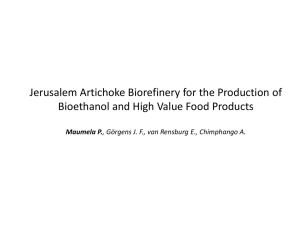
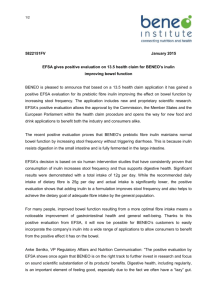
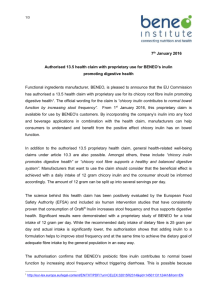
![[címlap külön, Corel Draw fájl]](http://s3.studylib.net/store/data/007395197_1-490526be5eed1fcd6beaa6da95c2a140-300x300.png)
